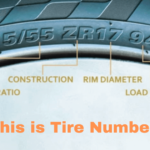Unveil speed limits on spare tires with our guide. Learn how fast can you go on a spare tire, ensuring a safe journey. Explore speed limits & drive confidently!
Understanding the limitations of your spare tire is crucial for safe driving. Spare tires, often known as ‘donuts’, are designed for temporary use and to get you to a service station or tire shop for a replacement.
Unlike full-size tires, these compact, lightweight spares are not built for long-term use or high-speed travel.
Recognizing these restrictions helps to maintain your safety and the integrity of your vehicle while on the road.
It’s important to check your owner’s manual for specific recommendations for your vehicle, as some compact spares might have different speed or distance limitations.
Regularly inspecting the condition of your spare tire, including its pressure, ensures it’s ready should an unexpected flat tire occur.

Credit: riiroo.com
The Role Of The Spare Tire
The Role of the Spare Tire is crucial in vehicle safety and mobility. It serves as a standby for your car’s regular tires.
When you face a flat tire, the spare tire becomes your best friend. It ensures you’re not stranded and can move to a safe location or a mechanic. But, how fast can you drive on it?
Origin And Design
Spare tires have a rich history in the automotive world. They came into play as car owners sought ways to deal with flats efficiently.
Originally, these tires matched the regular ones in size and type.
Today, most are smaller and lighter, designed for temporary use. They help reduce the vehicle’s weight and save space.
Temporary Solution During Tire Emergencies
A spare tire acts as a band-aid when you get a flat tire. It is not for long-term use or high speeds. It’s built with different materials and has different performance capabilities than your standard tires.
They have a speed limit, usually around 50 mph, and are safe to use for short distances, normally not exceeding 70 miles. Their purpose is to help you reach a service station or your home to replace the tire with a permanent one.
| Property | Regular Tire | Spare Tire |
|---|---|---|
| Material | Durable Rubber | Lightweight |
| Design | Long-term use | Compact |
| Speed Limit | Varies | ~50 mph |
| Distance Limit | Varies | ~70 miles |
Remember:
- Check your spare tire regularly.
- Know the limits of your spare to stay safe.
- Replace your spare with a regular tire as soon as possible.
It is essential to understand the spare tire’s limited role. They ensure safety during a tire emergency. Be mindful of speed and distance restrictions when using the spare tire.
Speed Restrictions On Spare Tires
Driving with a spare tire requires extra caution. Understanding speed limitations is essential for safety. Spare tires are not built to perform like regular tires. They have specific speed restrictions.
Manufacturer Recommendations
Manufacturers provide guidelines for spare tire usage. Always check the owner’s manual first. The manual includes the recommended maximum speed for your specific spare.
Typically, this speed is around 50 miles per hour (mph). Strictly adhere to this limit to avoid tire damage or vehicle mishandling.
- Compact spares are smaller and rated for short distances, usually up to 70 miles.
- Full-size spares match your regular tires but may have speed limits if they differ in wear or type.
- Check the tire sidewall for an imprinted speed limit if the manual is unavailable.
Risks At High Speeds
Exceeding the speed limit on a spare tire can lead to risks. High-speed driving on a spare causes:
| Risk Factor | Consequence |
|---|---|
| Reduced Handling | Poor control and longer braking distances. |
| Increase in Tire Wear | Faster degradation of the spare. |
| Potential Tire Failure | Blowouts that endanger all passengers. |
Always maintain a safe, moderate speed when driving on a spare tire. Avoid highways if possible. Plan a visit to a tire specialist promptly to replace the spare with a regular tire.
Your safety and the safety of others on the road depends on respecting these limits. Remember, a spare tire is a temporary fix, not a permanent solution. Stick to low speeds and head straight to your nearest tire service.
Types Of Spare Tires And Their Limits
Knowing about Types of Spare Tires and Their Limits is critical for safety. Spare tires are not all the same. Each type is different.
They have their own speed and distance limits. This knowledge can help you drive safely when using a spare tire. Understanding these limits is crucial for any driver.
Full-size Spares Versus Donuts
There are two main types of spare tires: full-size spares and donut spares. A full-size spare is just like the regular tires on your car.
It matches in dimensions and design. This type allows you to drive without immediate pressure to replace it, but it’s heavy and takes up more space.
| Full-Size Spare Tire | Donut Spare Tire |
|---|---|
| Uses regular speed limits | Limited to 50 mph |
| No specific distance limit | Use for 70 miles or less |
| Same size as other tires | Smaller and only for emergencies |
A donut spare, on the other hand, is much smaller. It’s also known as a space-saver tire. Donuts are meant for short-term use.
They have speed limits usually around 50 mph. They are light and compact. You shouldn’t drive on a donut for more than 70 miles. Using a donut changes how the car handles.
Compact Spares: Built For Limited Use
A compact spare is slightly different from a donut. Compact spares are smaller than full-size but slightly bigger than donuts. They are still designed for temporary use.
Car manufacturers advise staying below 50 mph with these tires too. They also suggest limiting the driving distance to a maximum of 70 miles.
- Lower speed prevents damage and maintains control.
- Limited distance avoids wear on the tire not built for long-term use.
- Compact size saves space but is still only a temporary solution.
Always check your spare tire’s condition. Knowing your spare’s capabilities keeps you safe.
Remember, these tires are a short-term fix. Plan to replace them with regular tires as soon as possible.

Credit: www.caranddriver.com
Impact Of Spare Tires On Vehicle Handling
The impact of spare tires on vehicle handling is a crucial aspect to consider when you’re driving on one. These temporary solutions can affect your car’s performance in more ways than you might think.
Altered Dynamics And Control
Using a spare tire changes how your vehicle behaves on the road. Here’s how:
- Reduced grip.
- Unbalanced braking.
- Uneven wear on tires.
Uneven weight distribution leads to a shift in your car’s center of gravity. This effects how the car turns and stops.
| Normal Tire | Spare Tire |
|---|---|
| Stable handling | Potential over or understeer |
| Consistent braking | Altered stopping distance |
Safety Considerations
Your safety is vital. Keep these points in mind with a spare:
- Avoid high speeds.
- Replace spare as soon as possible.
Stick to a maximum speed of 50 mph on a spare tire. Doing so helps prevent loss of control.
Don’t forget that spare tires are temporary solutions. Inspect your regular tires and repair them quickly to ensure you’re always driving safely.
Extending The Life Of Your Spare
Imagine you’re on a long drive and suddenly, you hear that dreaded flap-flap sound. You have a flat tire! You put on the spare tire, but the journey doesn’t end there.
To keep moving forward smoothly and safely, it’s crucial to extend the life of your spare tire.
Proper Maintenance
Regular checks on your spare tire are vital for road safety. Perform these simple steps to ensure your spare tire stays in mint condition:
- Inspect for any visible damage or wear.
- Check the pressure monthly, just like your regular tires.
- Keep it clean and dry to prevent corrosion.
- Store it in a cool, shaded place away from direct sunlight.
Following these tips can mean the difference between a reliable spare and a second breakdown.
When To Replace Your Spare
Your spare tire is like a silent guardian – always ready but often forgotten. Knowing when to replace it is crucial. Here are the signs:
| Sign | Action Needed |
|---|---|
| Visible cracks or cuts | Replace immediately |
| Outdated (6 years or older) | Time for a new one |
| Worn tread | Get a new spare |
Be proactive. Recording the last date of inspection helps you stay on top of your spare tire’s health. Your diligence extends its life and keeps you safe on the road.

Credit: www.yankodesign.com
Frequently Asked Questions On How Fast Can You Go On A Spare Tire
What Happens If You Go Too Fast On A Spare Tire?
Driving too fast on a spare tire risks blowouts, loss of control, and potential accidents. Stick to the recommended speed limit—usually 50 mph or less—to ensure safety and avoid damaging your vehicle.
Can I Drive On A Spare Tire For 2 Days?
Driving on a spare tire for more than 50 miles or at speeds over 50mph is not recommended. Replace it with a full-sized tire as soon as possible to ensure safe driving.
Can You Drive 55 Mph On A Spare Tire?
It’s not advisable to drive 55 mph on a spare tire. Most spares, especially “donut” types, recommend a top speed of 50 mph. Always check your spare tire’s limitations and drive cautiously.
How Long Can You Realistically Drive On A Spare Tire?
You should only drive on a spare tire for 50 to 70 miles. Aim to replace it with a full-size tire as soon as possible, preferably within 24 hours or less.
Conclusion
Wrapping up, safety comes first when driving on a spare tire. Keep speeds below 50 mph and replace it with a full-size tire as soon as possible.
By respecting this limit, you ensure a safe journey to your destination and protect your vehicle from potential damage.
Safe travels!

Sudatta is a passionate automotive enthusiast and expert in the field. With a keen eye for detail and a love for all things automotive, he shares insightful articles and reviews to ignite the automotive passion in readers.




